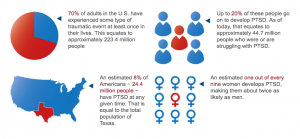List of Medical Claims regarding Post-Traumatic Stress Disorder and and Benefits Cognitive Processing Therapy:
- Type of anxiety disorder
- Sleep problems
- Be a “shoulder to cry on” – support and listen (not redirect to other thoughts)
- PTSD is treatable
- Cognitive Processing Therapy is beneficial, which says changing thoughts will change feelings.
- Lack of serotonin after traumatic event
- PTSD is not called that name immediately after a trauma, but Acute Stress Disorder
- fMRI is used to test the brain while it is working (e.i. Amygdala is overactive)
- Hippocampus is smaller when a person has PTSD

Statistics:
Many people all over the world experience different severities of traumas in their lives. Often times, some children survive traumatic experiences easily; however, most children are affected by certain stressors long-term; especially, the ones who encountered severe stress or developed an injury.

Summary of Articles:
Post-Traumatic Stress Disorder (PTSD) is a collection of feeling/behavior of avoidance, which may include bypassing a place where trauma occurred or diverting attention to something different. Medical researchers and professional believe that PTSD is treatable. They are continuously recommending therapeutic treatments to overcome trauma, and live or adjust to current life situation post traumatic event such as Cognitive Processing Therapy (CPT).
Cognitive processing therapy is a specific type of cognitive behavioral therapy that has been effective in reducing symptoms of PTSD that have developed after experiencing a variety of traumatic events including child abuse, combat, rape and natural disasters (APA, 2017).
Walter, et.al. (2014) compares the effectiveness of Cognitive Processing Therapy and Cognitive Processing Therapy – Cognitive Only (CPT-C) among veterans who are suffering with PTSD and Traumatic Brain Injury (TBI). As a result, authors find that CPT-C acts swifter in reducing episodes of PTSD compared to CPT. On a different note, Stirman, et.al. (2017) posits that regardless of efficacy of therapies for mental health disorders, some providers are not able to provide a full evidence-based psychotherapies to mental health patients.
McCarthy and Petrakis (2011) talks about the relationship between alcohol dependency (AD) and PTSD. Authors claim that although substance abuse and PTSD are two different mental health disorders; however, many are still suggesting that a both disorders should be treated simultaneously. Indeed, I believe that one disorder (e.i. Alcohol abuse) is an after-effect of another disorder (e.i. PTSD); therefore, a person with the two ailments should be provided with therapy that addresses both disorders. Moreover, this article studies the efficacy of Cognitive Processing Therapy – Cognitive. The result of this study conveys that CPT-C is an effective therapy to reduce the incidence or decrease the episode of alcohol abuse of the veterans suffering from PTSD.
Fact or Fiction:
Statistics have shown numbers to support the fact that many people are diagnosed with PTSD. According to Dr. Arutt, many people who experience traumatic events do not immediately and voluntarily deal with it; instead, are more likely to experience avoidance.
To that end, post-traumatic stress disorder is known to be a life-changing disorder. People are not born with it, but this is something that is event-related. Treating this type of mental health disorders should be taken seriously. In addition, should be highly encouraged; because, indeed, I believe and agree that post-traumatic stress disorder can be treated; it may be challenging, but there is always hope.
References:
McCarthy, E., & Petrakis, I. (2011). Case report on the use of cognitive processing therapy-cognitive, enhanced to address heavy alcohol use. Journal of Traumatic Stress, 24(4), 474–478. https://library.neit.edu:2404/10.1002/jts.20660
Stirman, S. W., Finley, E. P., Shields, N., Cook, J., Haine-Schlagel, R., Burgess Jr, J. F., Burgess, J. F., Jr. (2017). Improving and sustaining delivery of CPT for PTSD in mental health systems: a cluster randomized trial. Implementation Science, 12, 1–11. https://library.neit.edu:2404/10.1186/s13012-017-0544-5
Walter, K. H., Dickstein, B. D., Barnes, S. M., & Chard, K. M. (2014). Comparing Effectiveness of CPT to CPT-C Among U.S. Veterans in an Interdisciplinary Residential PTSD/TBI Treatment Program. Journal of Traumatic Stress, 27(4), 438–445. https://library.neit.edu:2404/10.1002/jts.21934
Media References:
MedCircle, 2018. What PTSD Symptoms Actually Look Like, According To The DSM 5 (Ep 3) Retrieved from: https://www.youtube.com/watch?v=Md7teBWB3fk
Resick, P., 2016. Cognitive Processing Therapy for PTSD. Retrieved from: https://www.youtube.com/watch?v=Abd6b4FArQQ&list=PLuYIOf5D2m9mK5UuxQ3yMcIw00M-S8pj
Tuerk, P., 2015. Return from Chaos: Treating PTSD. Retrieved from: https://www.youtube.com/watch?v=ORs3-tRokGU&list=PLuYIOf5D2m9mK5UuxQ3AyMcIw00M-S8pj&index=2
Additional References:
APA, 2017. Cognitive Processing Therapy (CPT). Retrieved from: https://www.apa.org/ptsd-guideline/treatments/cognitive-processing-therapy
